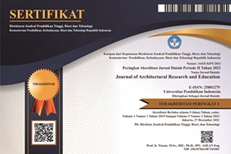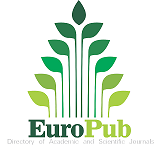Exploring Genius Loci through a Phenomenological Approach: A Study of Malalayang Beach Walk in Manado City
Abstract
Keywords
Full Text:
PDFReferences
Carmona, M., Heath, T., Oc, T., & Tiesdell, S. (2003). Public Space–Urban Space, The Dimention of Urban Design. Edisi, 2, 114.
Carr, S. (1992). Public Space. Cambridge University Press.
Creswell, J. W. (1994). Research Design: Qualitative and Quantitative Approaches. SAGE Publications.
Ersina, S., Amalia, A., & Sutriani, S. (2014). GENIUS LOCI PADA PERKAMPUNGAN TRADISIONAL SENARU SUKU SASAK KABUPATEN LOMBOK BARAT. Nature : National Academic Journal of Architecture, 1(2), 196–203.
Gehl, J. (2012). Life Between Buildings: Using Public Space. Island Press.
Habibullah, S., & Ekomadyo, A. S. (2021). PLACE-MAKING PADA RUANG PUBLIK: MENELUSURI GENIUS LOCI PADA ALUN-ALUN KAPUAS PONTIANAK. Jurnal Pengembangan Kota, 9(1), 36–49.
Hale, J. (2000). Building Ideas: An Introduction to Architectural Theory.
Hanifati, K., & Harjoko, T. Y. (2020). Arsitektur Sebagai Fenomena Kehadiran Manusia. Prosiding (SIAR) Seminar Ilmiah Arsitektur, 130–138.
Kaffah, M. F., & Ekomadyo, A. S. (2022). GENIUS LOCI KAMPUNG BANDAR PEKANBARU. Nature: National Academic Journal of Architecture, 9(1), 42–54. https://doi.org/10.24252/nature.v9i1a4
Kepczynska-Walczak, A., & Walczak, B. M. (2015). Built heritage perception through representation of its atmosphere. Ambiances, 1.
Monoarfa, A. A. S., Egam, P. P., & Tungka, A. E. (2021). ANALISIS KAWASAN STRATEGIS SOSIAL BUDAYA DI KOTA MANADO. SPASIAL, 8(1), 1–11.
Norberg-Schulz, C. (1980). Genius Loci: Towards a Phenomenology of Architecture. Rizzoli.
Owen, C. (2008). Architecture Between the Culture-Nature Dualism: A Case Study of Geoffrey Bawa’s Kandalama Hotel. International Journal of Architectural Research: Archnet-IJAR, 2(1).
Paravicini, U. (2003). Public Spaces as a Contribution to Egalitarian Cities. In City and Gender (pp. 57–80). VS Verlag für Sozialwissenschaften.
Peraturan Pemerintah RI. (2024). Peraturan Presiden (Perpres) Nomor 16 Tahun 2024 tentang Rencana Induk Destinasi Pariwisata Nasional Manado-Likupang.
Santoso, J. (2006). Kota Tanpa Warga. Kepustakaan Populer Gramedia.
Santri, T., & Putri, T. N. (2020). Genius Loci Permukiman Nelayan Pantai Utara Tuban Jawa Timur (Studi Kasus: Kelurahan Kingking Dan Kelurahan Karangsari). Jurnal Arsitektur ARCADE: Vol, 4(2).
Siregar, F. O. P., Takumansang, E., & Lintong, S. (2024). KAJIAN MITIGASI BENCANA PADA RUANG PUBLIK KAWASAN PESISIR KAWASAN MEGAMAS KOTA MANADO. JAMBURA Journal of Architecture, 6(1), 139–147.
Supriyadi, B. (2008). Kajian Waterfront di Semarang. Jurnal Ilmiah Perancangan Kota Dan Permukiman, 7(1), 50–58.
van Manen, M. (2017). But Is It Phenomenology? Qualitative Health Research, 27(6), 775–779.
DOI: https://doi.org/10.17509/jare.v7i2.90658
Refbacks
- There are currently no refbacks.
Copyright (c) 2025 Journal of Architectural Research and Education

This work is licensed under a Creative Commons Attribution-NonCommercial-ShareAlike 4.0 International License.

This work is licensed under a Creative Commons Attribution-ShareAlike 4.0 International License.








